
Liquid yeast is simultaneously one of the more rewarding and frustrating products that homebrew retailers work with. On the one hand, carrying liquid yeasts allows brew shops to offer their customers an extremely diverse selection of fermentation options, cater to very specific needs, and greatly expand the potential for batch-to-batch experimentation. On the other hand, liquid yeast is a low margin product, has a relatively short ideal shelf life, and it’s difficult to stock what everyone would like due to the extreme diversity available. So, we decided to do a little experiment, given that we occasionally have yeast that goes past its recommended usage date and we hate the waste of throwing it away.
The Setup
In order to determine how old yeast would have to be before it could no longer be salvaged, we decided to use a pack of yeast that was produced over two years ago. We had one pack of Wyeast 2042 (Danish Lager) manufactured on September 20, 2012 (Fig. 1), and our goal was to grow the remaining yeast and demonstrate that it could still ferment successfully. We took a very basic approach and simply put together a 1500ml yeast starter in a 2000ml flask with a 1.035 starting gravity and built it up on a magnetic stir plate.
The Execution
The starter showed a little bit more lag time than a fresher yeast would have, but that was expected. We started to see visible signs of yeast activity after 12 hours (Fig. 2) and we allowed it to continue for another 24 hours. After the 36-hour period was up the yeast starter was removed from the stir plate and placed in the refrigerator for a brief period in order to allow the yeast to separate and settle to the bottom of the flask. While the yeast was settling, we prepared .5 gallons of un-hopped wort at 1.040 starting gravity and transferred it to a glass growler. We aerated the wort and brought it to an appropriate pitching temperature, decanted the majority of the liquid from the starter, and pitched the remaining slurry. The “batch” showed activity after 12 hours and was allowed to continue for 10 more days.

The Results

After 10 days of fermentation the batch dropped from 1.040 starting gravity to 1.008 final gravity (Fig. 3). Thus, the yeast exhibited 80% attenuation in this particular fermentative context. The batch also displayed no major organoleptic flaws, which was a nice plus.
The Conclusion
This experiment was designed to simply prove that yeast that was over 1.5 years past its expiration date could be used to ferment, and it did. The experiment shows that, despite the age of the product, there are still viable cells and they can be grown over time and used to ferment. However, it is worth pointing out that we only used the culture we grew in a .5-gallon batch of low gravity wort. In a typical fermentation you will probably be dealing with a larger volume of wort at a higher gravity and it is worth mentioning that the yeast would need to be put through several more stages (steps) in growth before you would have the requisite number of cells. In order to accomplish this you would simply build another starter at the point where we pitched ours to the .5-gallons of wort.
So, the takeaway here is that yeast is much more resilient than the manufacturer’s expiration date would lead you to believe. If you have even a basic understanding of yeast growth then you can easily build up a starter from that vial or pack that sat in your fridge for a couple of months too long. Waste not, and brew on!

Peter says
It’s good to know that yeast packets sold close to expiration (or far past, as tested) can still do a good job of fermentation. My problem is paying top price for a product that is not “new”. I have experienced LHBS trying to hand you yeast that is near the best by date expiration and charging full price.
Gary says
I am currently doing the same experiment with a german lager yeast. It is almost two years past the date. I bought this when it was past the date at a Homebrew store for I think a dollar, with the intent of doing this earlier. It is currently on the stir plate with a 1500ml 1.045 starter. I plan to run it two more cycles in hopes to have a viable starter.
ashley says
Cool! Please let us know how it turns out.